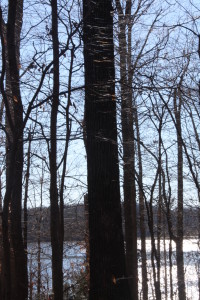As I mentioned in my last post, we are still very much in the beginning stages of understanding spider conservation. At this point, it may be that we can really only speak to general trends, rather than specific conservation situations, but certainly we’ve got a starting point.
Spiders are particularly sensitive to vegetative structure, meaning how tall and thick vegetation is, as well as which plant species are present, and part of that sensitivity seems to relate to how they respond to unstable environments. Hogg and Daane (2011) found that, while non-native spiders tended to have a relatively constant abundance throughout California vineyards, native spider abundance decreased with distance from the surrounding woodlands. They suggested that the more stable conditions in the woodlands provided better habitat for native spiders. A study in Switzerland also suggested that more stable habitats, such as sections of land that are left fallow for several years, may provide important over-wintering habitat for spiders who later spread into adjacent disturbed areas (Schmidt et al. 2008).

The horizontal streaks of silver are from spiders riding the wind in western Kentucky- ballooning in December…
Those fragments of undisturbed, or less-disturbed, habitat may be very important in maintaining spider diversity over the long-term– a study in Brazil found that local spider abundance was generally low across the study area and suggested that spiders may be slow, overall, to recolonize areas (Pinto-Leite, Guerrero, & Brazil 2008). In South Africa, Gaigher and Samways (2014) found that natural habitat fragments were relatively rich in rare spider families and species. Getting out of those refugia and into new areas is another important part of the spider diversity puzzle. When roadsides in France with and without hedgerows were compared for spider abundance and species diversity, the presence of hedgerows was significantly tied to the group of spider species found in a location (Le Viol et al. 2008). Spiders that use their own locomotion to disperse were more common in roadsides with hedgerows, while spiders that hitch a ride on animals or the wind were more common in roadsides without them. (Hunting method was also connected to vegetation- webs in places with hedgerow, ground foragers in places without them.) If the presence of hedgerows can influence the spider community so much, it’s worth thinking about all of the ways that we (and other forces) alter the vegetation around us.
So, let’s say that a spider species has been negatively impacted by a change in vegetation- can we do something to reverse that trend? If loss of plant structure and leaf litter is the issue (meaning, do we mow and till the area?), we can set aside strips as refuges and, if the field has several distinct zones of vegetation, try to set up tracts that are perpendicular to the plant zones (Cattin et al. 2003). If the issue is invasion by alien vegetation, a study from South Africa suggests that physically removing the plant makes an immediate difference (Mgobozi, Somers & Dippenaar-Schoeman 2008). However, if that removal program uses surfactant sprays to apply herbicides to plants, we need to rethink our strategy- a study in New Zealand found that, while the herbicides used to control invasive lupins were not fatal to spiders, the surfactants used to get the herbicides to stick to plants had a spider mortality rate of about 30% (Evans, McCaw & Beggs 2009).
The strategies mentioned above are ones that can be used on a variety of scales, from entire preserves to one’s own back yard- there probably other ways we can support spider species, too, so my final post for the month will look in that direction.
Works cited:
Cattin, M-F, Blandenier, G, Banasek-Richter, C and L-F Bersier. 2003. The impact of mowing as a management strategy for wet meadows on spider (Araneae) communities. Biol Conserv 113: 179-188.
Evans, AM, McCaw, J and W Beggs. 2009. Could herbicide used to control alien weeds be harming threatened New Zealand spiders? J. Appl. Entomol. 133: 767-770.
Gaigher, R and MJ Samways. 2014. Insect Conserv and Diver 7: 470-479.
Hogg, BN and KM Daane. 2011. Ecosystem services in the face of invasion: the persistence of native and nonnative spiders in an agricultural landscape. Ecol. Appl. 21: 565-576.
Le Viol, I, Julliard, R, Kerbiriou, C, de Redon, L, Carnino, N, Machon, N and E Porcher. 2008. Plant and spider communities benefit differently from the presence of planted hedgerows in highway verges. Biol Conserv 141: 1581-1590.
Mgobozi, MP, Somers, MJ and AS Dippenaar-Schoeman. 2008. Spider responses to alien plant invasion: the effect of short- and long-term chromolaena. J. Appl. Ecol. 45: 1189-1197.
Pinto-Leite, CM, Guerrero, AC and TK Brazil. 2008. Non-random patterns of spider species composition in an Atlantic rainforest. J. Arach. 36: 448-452.
Schmidt, MH, Rocker, S, Hanafi, J and A Gigon. 2008. Rotational fallows as overwintering habitat for grassland arthropods: the case of spiders in fen meadows. Biodivers Conserv 17: 3003-3012.
